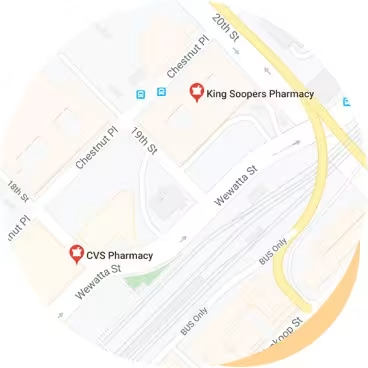- Chronic Care
Abdominal Pain
Abdominal pain and discomfort treatment available online today
Request treatment for abdominal pain and discomfort online from our trusted, board-certified doctors and find relief today. Get a new prescription to treat abdominal pain or refill an existing prescription today.*
Book an appointmentHelps relieve abdominal pain and discomfort
Receive personalized care and treatment
Get relief with doctor-recommended prescriptions
*Prescriptions are provided at the doctor's discretion. Learn more about our controlled substances policy and how to save up to 80% with our prescription discount card. PlushCare doctors cannot treat all cases of abdominal pain and discomfort. Our primary care physicians can conduct an initial evaluation of your symptoms but may need to refer you to a specialist or for in-person treatment. If you are experiencing life-threatening symptoms, seek emergency medical attention immediately.

Learn about abdominal pain and discomfort
Abdominal pain is characterized by discomfort anywhere in the abdominal region. Most of the time, we think of abdominal pain as "stomach pain," but belly pain can come from other parts of the body.
Some common types of abdominal pain may include:
Localized pain (pain limited to one area of the abdomen)
Generalized pain (pain in more than half of the abdomen)
Colicky pain (pain that may indicate more serious medical conditions)
Cramp-like pain (often associated with bloating, diarrhea, and constipation)
Abdominal pain causes
There are several potential causes of abdominal pain, including:
Digestive issues - If you experience belly pain after eating, it may be related to gas, indigestion, or food allergies.
Inflammation - Irritation or infection in your organs can lead to temporary inflammation and abdominal discomfort.
The female reproductive cycle - If you have a uterus, you may experience mild abdominal pain from menstrual cramps and ovulation.
If you experience abdominal pain throughout the whole region of your abdomen, you might have a diagnosable medical condition such as:
Abdominal pain symptoms
Depending on the cause of your abdominal pain, your pain may range from mild to severe. Sometimes, stomach cramps and discomfort can come on suddenly or gradually build up. You might experience chronic abdominal pain or sharp abdominal pain that comes in waves.
The symptoms of abdominal pain may include:
Mild or severe pain in the abdomen
Gas or stomach cramps
Poor appetite
Diarrhea or constipation
Bloating
*Disclaimer: Seek emergency medical treatment immediatelyif you are experiencing severe or life-threatening symptoms such as persistent vomiting, vomit that contains blood, pain so severe you cannot move, pain that lasts several hours, large swelling in the abdominal region, bloody or black bowel movements, trouble breathing, or yellowing skin.

How to treat abdominal pain and discomfort
Your treatment plan will depend on the cause of your pain. In many cases, treatment options include pain medication and preventive measures.
Abdominal pain medication
Depending on the cause of your pain, your doctor may recommend pain medication to treat abdominal discomfort. Some common medications for pain relief include:
Prescription medication
Prescription medications can effectively relieve pain and discomfort. Some of these medication options include:
Aluminum hydroxide and magnesium hydroxide
Camylofin
Hyoscyamine
Lansoprazole
Over-the-counter medication
If you're experiencing mild pain and discomfort, over-the-counter medication can ease mild abdominal pain. Some common OTC medications include:
Acetaminophen (aspirin)
Mild stool softeners
Antacids
Medicines with loperamide (Imodium) or bismuth (Pepto-Bismol)

How to prevent abdominal pain and discomfort
Not all types of abdominal pain are preventable. However, you can minimize your risk of pain and discomfort by:
Eating a healthy diet
Eating regular meals
Exercising regularly
Staying hydrated

When to see a doctor for abdominal pain and discomfort
If you do not know the cause of your pain and discomfort, talk to your doctor. In some cases, underlying medical conditions can contribute to stomach pain.
Seek emergency medical care if you are experiencing:
Fever
Persistent vomiting, bloating, or nausea
Blood in your stool
Pain in other parts of your body
Tenderness when you touch your abdomen
Shortness of breath
It is important to work with your doctor to diagnose your pain and discomfort.
Fortunately, we make it easy to have a video consultation with one of our doctors, who can talk to you about your symptoms and prescribe you the appropriate medication if you qualify.
Abdominal pain treatment FAQs
What is the best treatment for abdominal pain and discomfort?
The best treatment for abdominal pain and discomfort will depend on your specific symptoms and the underlying cause. Talk to your doctor to determine whether abdominal pain medication is the best option for you.
Is my abdominal pain serious?
If you experience severe pain, pain that worsens with movement, or a sudden onset of pain, talk to your doctor. Severe abdominal pain may be related to a serious medical condition.
What causes pain in the upper abdomen?
There are several potential causes of upper abdominal pain, including hepatitis, pneumonia, gallstones, or heart attack.
What causes abdominal pain in females?
Any of the above-mentioned conditions can cause discomfort in women. Some causes exclusive to women include:
Menstrual cramps
Ovarian cysts
Ectopic pregnancy
Miscarriage
Fibroids
Endometriosis
Pelvic inflammatory disease
Where is abdominal pain located?
Abdominal pain can occur anywhere in your belly region, between your ribs and your pelvis.
Depending on the cause, you might experience upper left abdominal pain, lower left abdominal pain, upper right abdominal pain, or lower right abdominal pain.
3 simple steps to request treatment for abdominal pain and discomfort today

Step 1
Book an appointment to treat abdominal pain.
Book a same day appointment from anywhere.

Step 2
Talk to your medical provider regarding your abdominal pain and discomfort symptoms.
Visit with a doctor on your smartphone or computer.

Step 3
Pick up a prescription to treat abdominal pain.
We can send prescriptions to any local pharmacy.
Abdominal pain treatment pricing details
How pricing works
To request abdominal pain and discomfort treatment and get a new prescription or refill on your prescription, join our monthly membership and get discounted visits
Paying with insurance
Membership
$16.99/month
First month free
Visits
Copay
30 days of free membership
Same-day appointments 7 days a week
Unlimited messages with your Care Team
Prescription discount card to save up to 80%
Exclusive discounts on lab tests
Free memberships for your family
Cancel anytime
Visit price with insurance
Often the same as an office visit. Most patients with in-network insurance pay $30 or less!
We accept these insurance plans and many more:
Paying without insurance
Membership
$16.99/month
First month free
Visits
$129
30 days of free membership
Same-day appointments 7 days a week
Unlimited messages with your Care Team
Prescription discount card to save up to 80%
Exclusive discounts on lab tests
Free memberships for your family
Cancel anytime
Visit price without insurance
Initial visits are $129.
If we're unable to treat you, we'll provide a full refund.
Related conditions to abdominal pain and discomfort
Appendicitis
Appendicitis is an inflammation of the appendix, a small pouch on the lower right side of your abdomen. Inflammation can cause pain in the lower right abdomen.
Irritable bowel syndrome (IBS)
IBS involves chronic pain anywhere in the abdomen, although it is most commonly reported in the lower abdomen. Eating may make the pain worse, while pain may be relieved during a bowel movement.
Crohn’s disease
Crohn's disease, a type of inflammatory bowel disease (IBD), causes inflammation of your digestive tract. People with Crohn's disease often experience abdominal pain, weight loss, and diarrhea.
Urinary tract infection
UTIs typically cause bladder-specific symptoms, such as cloudy urine. However, the bacteria can also affect the abdomen, especially the lower abdomen, leading to pressure, pain, and bloating.
Stomach flu
The "stomach flu" (which is different from influenza) can cause uncomfortable symptoms such as diarrhea, stomach pain, and nausea.
Sources:
PlushCare is dedicated to providing you with accurate and trustworthy health information.
Cleveland Clinic. Abdominal Pain. Accessed on June 15, 2022. https://my.clevelandclinic.org/health/symptoms/4167-abdominal-pain
Mayo Clinic. Abdominal Pain. Accessed on June 15, 2022. https://www.mayoclinic.org/symptoms/abdominal-pain/basics/definition/sym-20050728l-pain
MedlinePlus. Abdominal Pain. Accessed on June 15, 2022. https://medlineplus.gov/ency/article/003120.htm
PlushCare content is reviewed by MDs, PhDs, NPs, nutritionists, and other healthcare professionals. Learn more about our editorial standards and meet the medical team. The PlushCare site or any linked materials are not intended and should not be construed as medical advice, nor is the information a substitute for professional medical expertise or treatment.